Monalisa Chanakira McVitie's Campaign Report (PDF)
File information
This PDF 1.7 document has been generated by Adobe InDesign CC 2015 (Macintosh) / Adobe PDF Library 15.0, and has been sent on pdf-archive.com on 10/11/2016 at 10:36, from IP address 5.179.x.x.
The current document download page has been viewed 525 times.
File size: 473.48 KB (6 pages).
Privacy: public file
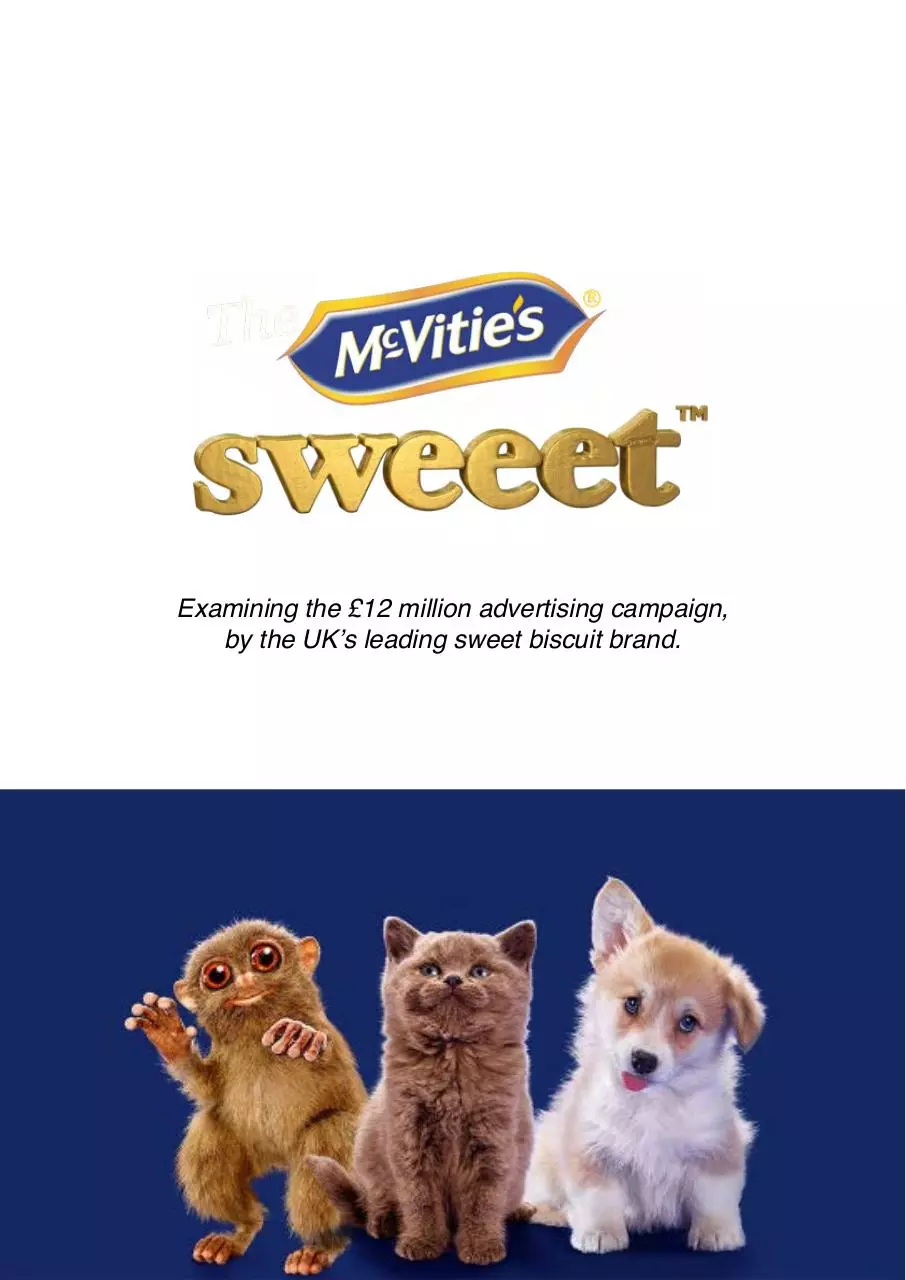
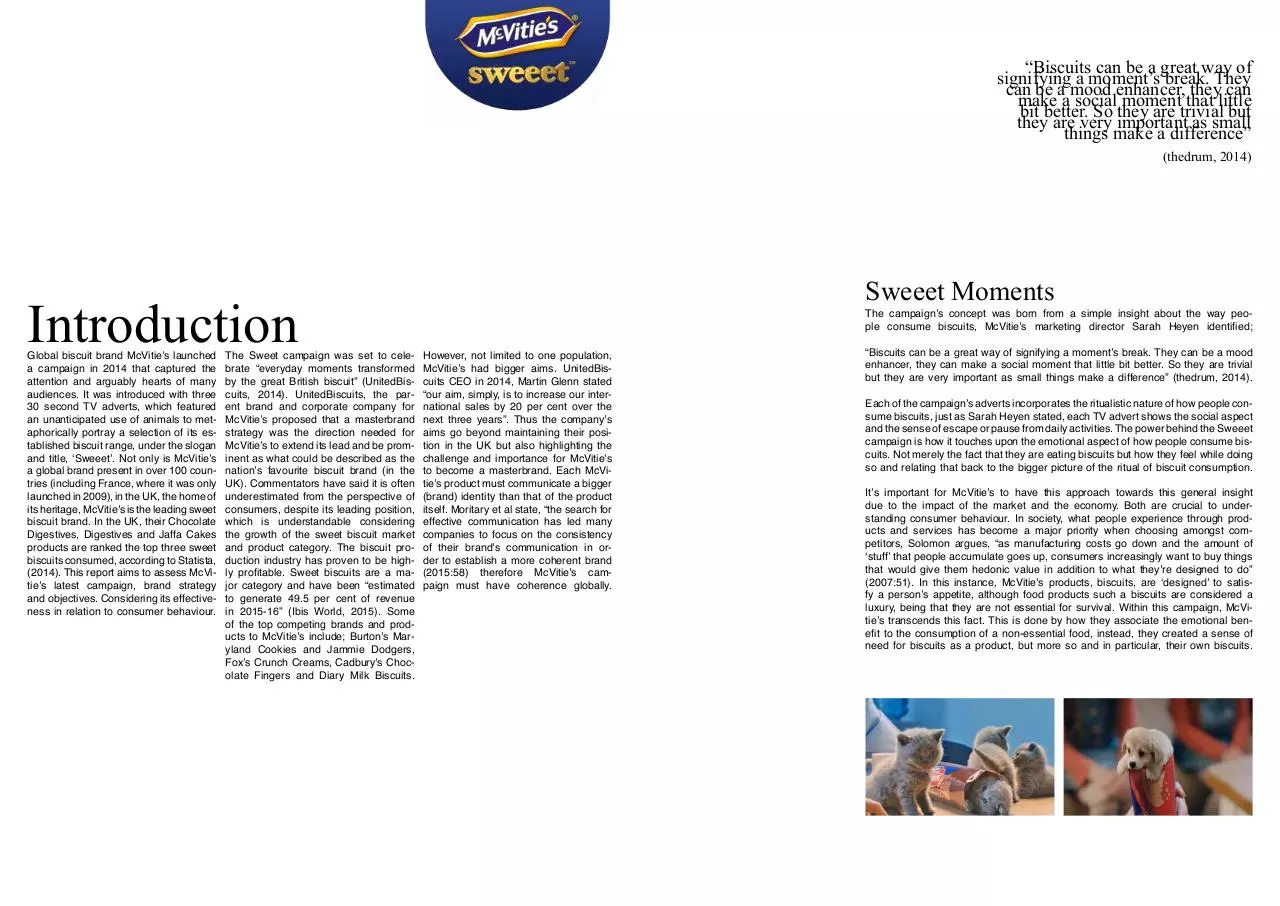
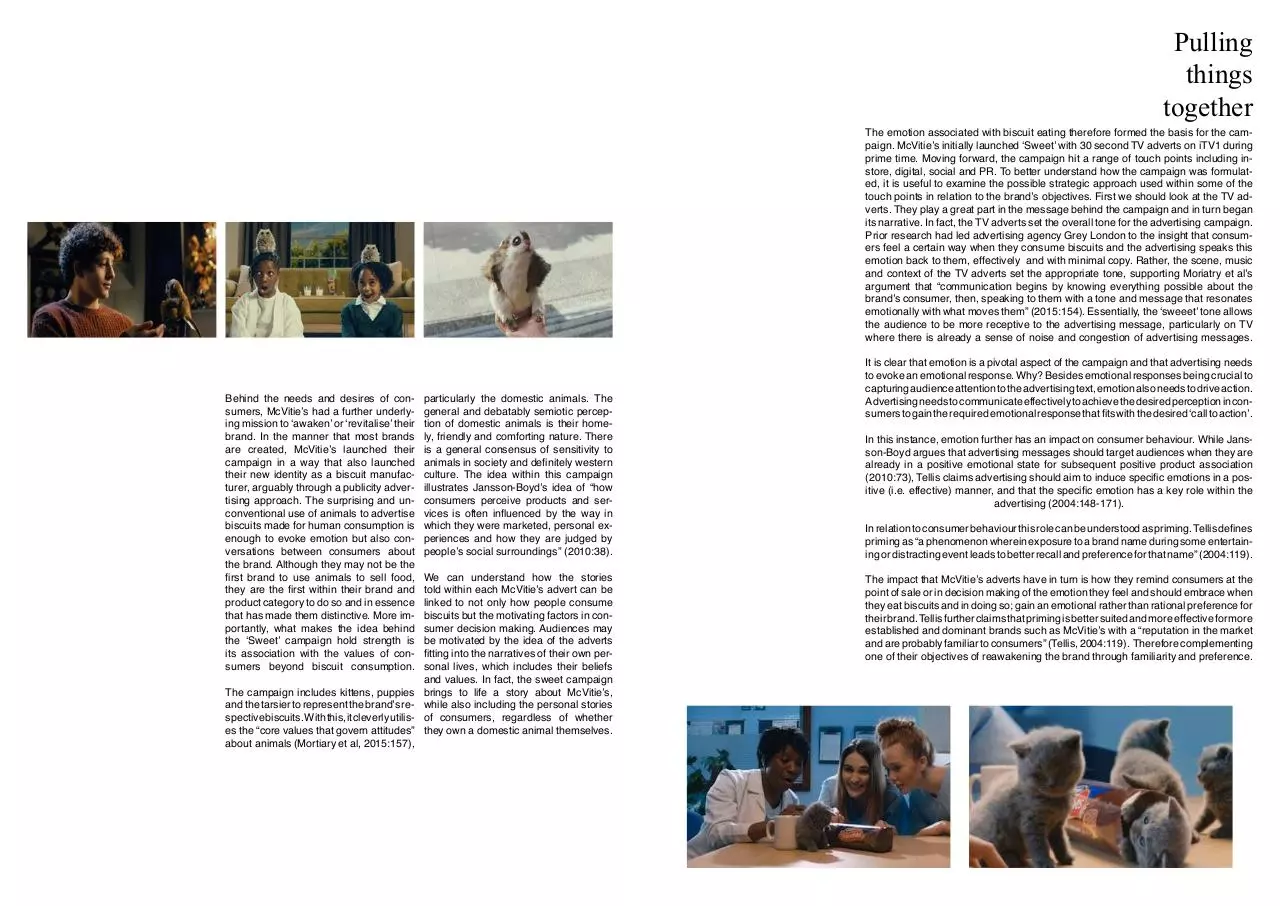

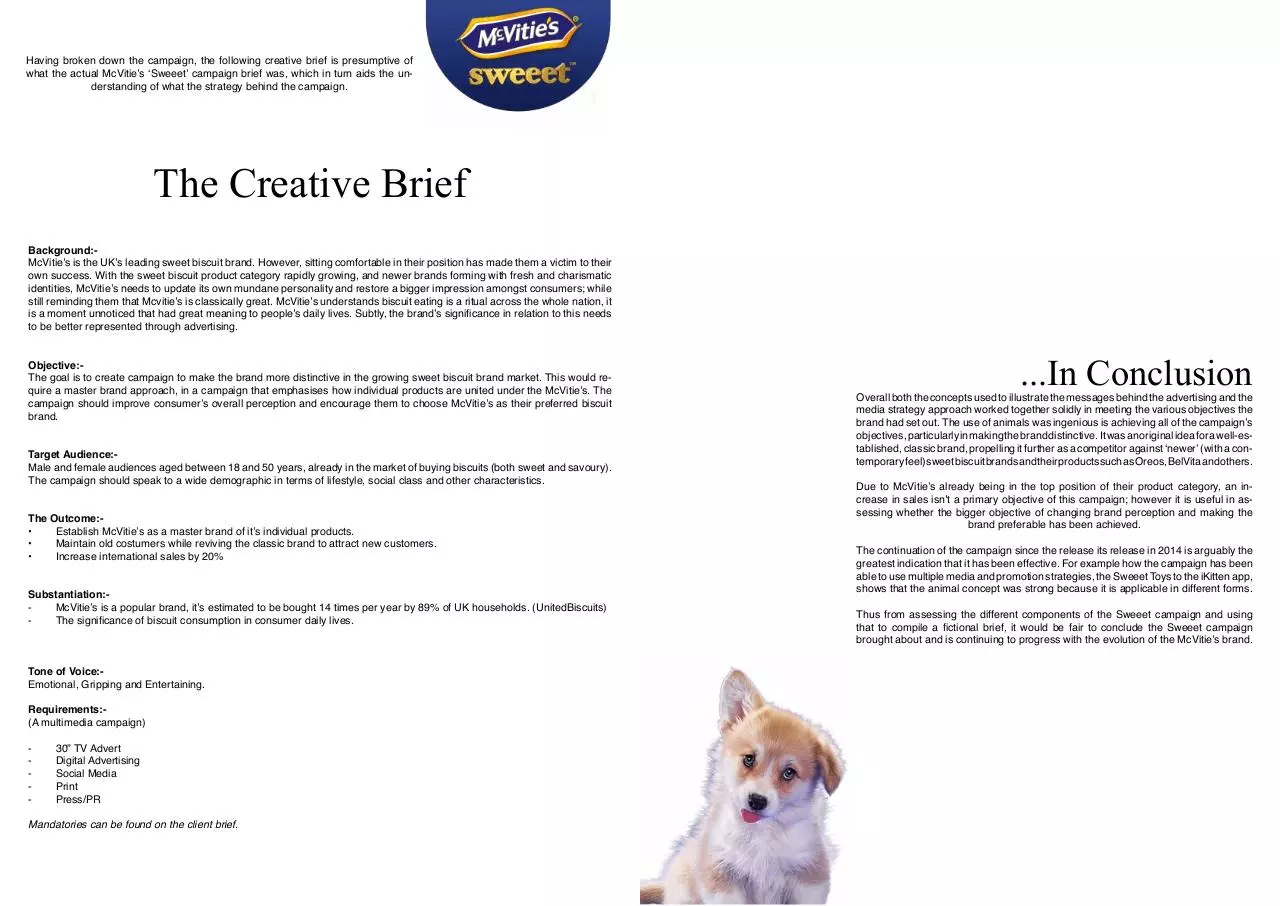
File preview
Examining the £12 million advertising campaign,
by the UK’s leading sweet biscuit brand.
“Biscuits can be a great way of
signifying a moment’s break. They
can be a mood enhancer, they can
make a social moment that little
bit better. So they are trivial but
they are very important as small
things make a difference”
(thedrum, 2014)
Introduction
Global biscuit brand McVitie’s launched
a campaign in 2014 that captured the
attention and arguably hearts of many
audiences. It was introduced with three
30 second TV adverts, which featured
an unanticipated use of animals to metaphorically portray a selection of its established biscuit range, under the slogan
and title, ‘Sweeet’. Not only is McVitie’s
a global brand present in over 100 countries (including France, where it was only
launched in 2009), in the UK, the home of
its heritage, McVitie’s is the leading sweet
biscuit brand. In the UK, their Chocolate
Digestives, Digestives and Jaffa Cakes
products are ranked the top three sweet
biscuits consumed, according to Statista,
(2014). This report aims to assess McVitie’s latest campaign, brand strategy
and objectives. Considering its effectiveness in relation to consumer behaviour.
The Sweet campaign was set to celebrate “everyday moments transformed
by the great British biscuit” (UnitedBiscuits, 2014). UnitedBiscuits, the parent brand and corporate company for
McVitie’s proposed that a masterbrand
strategy was the direction needed for
McVitie’s to extend its lead and be prominent as what could be described as the
nation’s favourite biscuit brand (in the
UK). Commentators have said it is often
underestimated from the perspective of
consumers, despite its leading position,
which is understandable considering
the growth of the sweet biscuit market
and product category. The biscuit production industry has proven to be highly profitable. Sweet biscuits are a major category and have been “estimated
to generate 49.5 per cent of revenue
in 2015-16” (Ibis World, 2015). Some
of the top competing brands and products to McVitie’s include; Burton’s Maryland Cookies and Jammie Dodgers,
Fox’s Crunch Creams, Cadbury’s Chocolate Fingers and Diary Milk Biscuits.
Sweeet Moments
The campaign’s concept was born from a simple insight about the way people consume biscuits, McVitie’s marketing director Sarah Heyen identified;
However, not limited to one population,
McVitie’s had bigger aims. UnitedBiscuits CEO in 2014, Martin Glenn stated
“our aim, simply, is to increase our international sales by 20 per cent over the
next three years”. Thus the company’s
aims go beyond maintaining their position in the UK but also highlighting the
challenge and importance for McVitie’s
to become a masterbrand. Each McVitie’s product must communicate a bigger
(brand) identity than that of the product
itself. Moritary et al state, “the search for
effective communication has led many
companies to focus on the consistency
of their brand’s communication in order to establish a more coherent brand
(2015:58) therefore McVitie’s campaign must have coherence globally.
“Biscuits can be a great way of signifying a moment’s break. They can be a mood
enhancer, they can make a social moment that little bit better. So they are trivial
but they are very important as small things make a difference” (thedrum, 2014).
Each of the campaign’s adverts incorporates the ritualistic nature of how people consume biscuits, just as Sarah Heyen stated, each TV advert shows the social aspect
and the sense of escape or pause from daily activities. The power behind the Sweeet
campaign is how it touches upon the emotional aspect of how people consume biscuits. Not merely the fact that they are eating biscuits but how they feel while doing
so and relating that back to the bigger picture of the ritual of biscuit consumption.
It’s important for McVitie’s to have this approach towards this general insight
due to the impact of the market and the economy. Both are crucial to understanding consumer behaviour. In society, what people experience through products and services has become a major priority when choosing amongst competitors, Solomon argues, “as manufacturing costs go down and the amount of
‘stuff’ that people accumulate goes up, consumers increasingly want to buy things
that would give them hedonic value in addition to what they’re designed to do”
(2007:51). In this instance, McVitie’s products, biscuits, are ‘designed’ to satisfy a person’s appetite, although food products such a biscuits are considered a
luxury, being that they are not essential for survival. Within this campaign, McVitie’s transcends this fact. This is done by how they associate the emotional benefit to the consumption of a non-essential food, instead, they created a sense of
need for biscuits as a product, but more so and in particular, their own biscuits.
Pulling
things
together
The emotion associated with biscuit eating therefore formed the basis for the campaign. McVitie’s initially launched ‘Sweet’ with 30 second TV adverts on iTV1 during
prime time. Moving forward, the campaign hit a range of touch points including instore, digital, social and PR. To better understand how the campaign was formulated, it is useful to examine the possible strategic approach used within some of the
touch points in relation to the brand’s objectives. First we should look at the TV adverts. They play a great part in the message behind the campaign and in turn began
its narrative. In fact, the TV adverts set the overall tone for the advertising campaign.
Prior research had led advertising agency Grey London to the insight that consumers feel a certain way when they consume biscuits and the advertising speaks this
emotion back to them, effectively and with minimal copy. Rather, the scene, music
and context of the TV adverts set the appropriate tone, supporting Moriatry et al’s
argument that “communication begins by knowing everything possible about the
brand’s consumer, then, speaking to them with a tone and message that resonates
emotionally with what moves them” (2015:154). Essentially, the ‘sweeet’ tone allows
the audience to be more receptive to the advertising message, particularly on TV
where there is already a sense of noise and congestion of advertising messages.
Behind the needs and desires of consumers, McVitie’s had a further underlying mission to ‘awaken’ or ‘revitalise’ their
brand. In the manner that most brands
are created, McVitie’s launched their
campaign in a way that also launched
their new identity as a biscuit manufacturer, arguably through a publicity advertising approach. The surprising and unconventional use of animals to advertise
biscuits made for human consumption is
enough to evoke emotion but also conversations between consumers about
the brand. Although they may not be the
first brand to use animals to sell food,
they are the first within their brand and
product category to do so and in essence
that has made them distinctive. More importantly, what makes the idea behind
the ‘Sweet’ campaign hold strength is
its association with the values of consumers beyond biscuit consumption.
The campaign includes kittens, puppies
and the tarsier to represent the brand’s respective biscuits. With this, it cleverly utilises the “core values that govern attitudes”
about animals (Mortiary et al, 2015:157),
particularly the domestic animals. The
general and debatably semiotic perception of domestic animals is their homely, friendly and comforting nature. There
is a general consensus of sensitivity to
animals in society and definitely western
culture. The idea within this campaign
illustrates Jansson-Boyd’s idea of “how
consumers perceive products and services is often influenced by the way in
which they were marketed, personal experiences and how they are judged by
people’s social surroundings” (2010:38).
We can understand how the stories
told within each McVitie’s advert can be
linked to not only how people consume
biscuits but the motivating factors in consumer decision making. Audiences may
be motivated by the idea of the adverts
fitting into the narratives of their own personal lives, which includes their beliefs
and values. In fact, the sweet campaign
brings to life a story about McVitie’s,
while also including the personal stories
of consumers, regardless of whether
they own a domestic animal themselves.
It is clear that emotion is a pivotal aspect of the campaign and that advertising needs
to evoke an emotional response. Why? Besides emotional responses being crucial to
capturing audience attention to the advertising text, emotion also needs to drive action.
Advertising needs to communicate effectively to achieve the desired perception in consumers to gain the required emotional response that fits with the desired ‘call to action’.
In this instance, emotion further has an impact on consumer behaviour. While Jansson-Boyd argues that advertising messages should target audiences when they are
already in a positive emotional state for subsequent positive product association
(2010:73), Tellis claims advertising should aim to induce specific emotions in a positive (i.e. effective) manner, and that the specific emotion has a key role within the
advertising (2004:148-171).
In relation to consumer behaviour this role can be understood as priming. Tellis defines
priming as “a phenomenon wherein exposure to a brand name during some entertaining or distracting event leads to better recall and preference for that name” (2004:119).
The impact that McVitie’s adverts have in turn is how they remind consumers at the
point of sale or in decision making of the emotion they feel and should embrace when
they eat biscuits and in doing so; gain an emotional rather than rational preference for
their brand. Tellis further claims that priming is better suited and more effective for more
established and dominant brands such as McVitie’s with a “reputation in the market
and are probably familiar to consumers” (Tellis, 2004:119). Therefore complementing
one of their objectives of reawakening the brand through familiarity and preference.
Strategy
With the concept and advertising strategy in place, McVitie’s had to figure out the
best approach to deliver the advertising
message with a media strategy. As stated before, the touchpoints of the campaign included TV, in-store, digital, social
and PR. It is clear the ‘Sweeet’ campaign
was intended to be a multimedia campaign, presumably to have the widest
reach to really emphasise the launch of
the brand’s new look (minor changes had
been made to the McVitie’s logo), and
identity as a master brand. Consumer
behaviour entails more than the simple
purchase of goods and services. It involves how people also “dispose of these
goods and services” as well as activities
around this that “satisfy their needs and
desires” (Noel, 2009:11). Thus through
recognising this, we can understand
the role of choosing certain media can
have on a campaign and that “consumers have specialised needs that media
can meet” (Baron and Sissors, 1919: 2).
emotional engagement” (Pradeep, 1963:
225). This could help assist in understanding why the content of the different
media platforms in the ‘Sweeet’ campaign differ slightly. For example, the TV
adverts for the campaign have people/
humans, supporting the notion to drive
emotional engagement by Pradeep but
also the emotional nature of the campaign
itself, while print, social media and digital
media only feature the animal characters
of the ‘Sweeet’ campaign narrative. Not
to claim the other media lacks the emotional tone the advertising desired but
we can assume that the print and digital
platforms are more focused on priming
and memory retention of the brand at
point of purchasing the product category.
Furthermore, Pradeep also claims his
studies have shown that “mobile and
internet environments give a significant
boost in memory retention for most of
the ads tested” arguing that this is due to
the need to focus on the usually smaller
There are various way to assess the screens and also how audiences tend to
suitability of the media used with- voluntarily engage with the devices that
in a campaign, some advantages and hold this media. (Pradeep, 1963: 225).
limitations more obvious than others. Pradeep (1963) takes a neurological stand point behind the effectiveness of communication through
different types of media to understand
consumer behaviour. He claims “the larger screen size of the TV platform helps
the human elements and fine details
shown in commercials to have the highest
The McVitie’s campaign strongly exemplifies both of these points. In 2016, they
continued their campaign with the launch
of the Chocolate Digestives campaign
in an interactive mobile app. After the
success of the initial launch of the campaign in 2014, marketing director, Sarah
Heyen proclaimed the brand wanted to
continue to celebrate the everyday biscuit eating moment with a focus on the
Chocolate Digestives product. The app,
called the ‘McVitie’s iKitten App’ was
an opportunity for the brand to take the
‘Sweeet moment’ from the TV screen,
to actively involving consumers in the
‘Sweeet experience’. The app allows
“consumers to play with their very own
virtual kitten” (UnitedBiscuits, 2016). Of
course, the launch of the app was accompanied with another TV advert within the series, although focusing on announcing the app but furthering the idea
of bringing the experience into the space
of consumers and showing that “as interconnectivity becomes easier, the
boundaries between screens is beginning to drop away” (Pradeep, 1963:221).
We can understand from the campaign’s
objectives why the brand utilised a wide
spectrum of media and the £12 million
budget only supported the strategy. Having maximum coverage further contributed to the relaunch of McVitie’s but within
this, the smaller campaigns such as the
iKitten app had within them, their own
strategies. With the Chocolate Digestives
product being more the most popular (in
terms of consumption) product of McVitie’s, it’s unsurprising the brand dedicated a whole app surrounding a benefit of
purchasing the product. For those who
wish to extend their sweeet experience
beyond TV advertising and after buying
the Chocolate Digestives, they could
do so by downloading the free app and
scanning their McVitie’s Chocolat Digestives wrapper to play with the iKitten,
being that the kitten was used to metaphorically portray this product in the TV
adverts. Moving beyond the campaign’s
initial adverts, this continued the campaign’s narrative and also illustrated the
success of the initial media platforms
used. Especially if the brand are now
focusing on audiences and consumers,
who are already in the market of buying
their specific products but at the same
time enticing new consumers. Mortiary
et al state “entertainment has always had
a positive value on advertising messages” (2015:134) and the interactive game
structure of the iKitten app is exactly that.
Having broken down the campaign, the following creative brief is presumptive of
what the actual McVitie’s ‘Sweeet’ campaign brief was, which in turn aids the understanding of what the strategy behind the campaign.
The Creative Brief
Background:McVitie’s is the UK’s leading sweet biscuit brand. However, sitting comfortable in their position has made them a victim to their
own success. With the sweet biscuit product category rapidly growing, and newer brands forming with fresh and charismatic
identities, McVitie’s needs to update its own mundane personality and restore a bigger impression amongst consumers; while
still reminding them that Mcvitie’s is classically great. McVitie’s understands biscuit eating is a ritual across the whole nation, it
is a moment unnoticed that had great meaning to people’s daily lives. Subtly, the brand’s significance in relation to this needs
to be better represented through advertising.
Objective:The goal is to create campaign to make the brand more distinctive in the growing sweet biscuit brand market. This would require a master brand approach, in a campaign that emphasises how individual products are united under the McVitie’s. The
campaign should improve consumer’s overall perception and encourage them to choose McVitie’s as their preferred biscuit
brand.
Target Audience:Male and female audiences aged between 18 and 50 years, already in the market of buying biscuits (both sweet and savoury).
The campaign should speak to a wide demographic in terms of lifestyle, social class and other characteristics.
The Outcome:•
Establish McVitie’s as a master brand of it’s individual products.
•
Maintain old costumers while reviving the classic brand to attract new customers.
•
Increase international sales by 20%
Substantiation:-
McVitie’s is a popular brand, it’s estimated to be bought 14 times per year by 89% of UK households. (UnitedBiscuits)
-
The significance of biscuit consumption in consumer daily lives.
Tone of Voice:Emotional, Gripping and Entertaining.
Requirements:(A multimedia campaign)
-
30” TV Advert
-
Digital Advertising
-
Social Media
-
Press/PR
Mandatories can be found on the client brief.
...In Conclusion
Overall both the concepts used to illustrate the messages behind the advertising and the
media strategy approach worked together solidly in meeting the various objectives the
brand had set out. The use of animals was ingenious is achieving all of the campaign’s
objectives, particularly in making the brand distinctive. It was an original idea for a well-established, classic brand, propelling it further as a competitor against ‘newer’ (with a contemporary feel) sweet biscuit brands and their products such as Oreos, BelVita and others.
Due to McVitie’s already being in the top position of their product category, an increase in sales isn’t a primary objective of this campaign; however it is useful in assessing whether the bigger objective of changing brand perception and making the
brand preferable has been achieved.
The continuation of the campaign since the release its release in 2014 is arguably the
greatest indication that it has been effective. For example how the campaign has been
able to use multiple media and promotion strategies, the Sweeet Toys to the iKitten app,
shows that the animal concept was strong because it is applicable in different forms.
Thus from assessing the different components of the Sweeet campaign and using
that to compile a fictional brief, it would be fair to conclude the Sweeet campaign
brought about and is continuing to progress with the evolution of the McVitie’s brand.
Bibliography
•
Jansson-Boyd, C. (2010) Consumer Psychology. McGraw Hill/Open University Press. Berkshire.
•
Noel, H. (2009) Basic Marketing 01: Consumer Behaviour. Ava Publishing. Switzerland.
•
Moriarty, E.S. Mitchell, N. Wellis, W. (2015) Advertising and IMC: Principles and Practice. Pearson. Harlow.
•
Pradeep, A.K. (1963) The Buying Brain: Secrets of Selling to the Subconscious Mind. John Waley and Sons Inc. New
Jersey.
•
Sissors, Z, J. Baron, B.R. (1919) Advertising Media Planning. McGraw Hill. New York.
•
Solomon, M.R. (2014) Consumer Behaviour: Buying, Having, Being. Pearson Education Canada. Toronto.
•
Tellis, J. G. (2004) Effective Advertising: Understanding When, How and Why Advertising Works. Sage Publications.
California.
•
IbisWorld. 2015. Biscuit Production in the UK: Market Research Report. [ONLINE] Available at:http://www.ibisworld.
co.uk/market-research/biscuit-production.html. [Accessed 19 March 2016].
•
Statista. 2014. Leading Sweet Biscuit Brands in the UK. [ONLINE] Available at:http://www.statista.com/statistics/302794/
leading-sweet-biscuits-brands-in-the-uk/. [Accessed 18 March 2016].
•
UnitedBiscuits. 2014. McVitie’s Unveils £12 million campaign celebrating everyday moments transformed by the great
British biscuit. [ONLINE] Available at:http://www.unitedbiscuits.com/news/corporate-news/mcvities-unveils-12-million-campaign-celebrating-everyday-moments-transformed-bythe-great-british-biscuit/. [Accessed 18 March 2016].
•
UnitedBiscuits. 2016. The sweeet™ kittens are back as McVitie’s launches new Chocolate Digestives campaign and
interactive mobile app. [ONLINE] Available at:http://www.unitedbiscuits.com/news/the-sweeet-kittens-are-back-as-mcvitieslaunches-new-chocolate-digestives-campaign-and-interactive-mobile-app/. [Accessed 19 March 2016].
Download Monalisa Chanakira - McVitie's Campaign Report
Monalisa Chanakira - McVitie's Campaign Report.pdf (PDF, 473.48 KB)
Download PDF
Share this file on social networks
Link to this page
Permanent link
Use the permanent link to the download page to share your document on Facebook, Twitter, LinkedIn, or directly with a contact by e-Mail, Messenger, Whatsapp, Line..
Short link
Use the short link to share your document on Twitter or by text message (SMS)
HTML Code
Copy the following HTML code to share your document on a Website or Blog
QR Code to this page
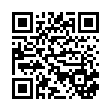
This file has been shared publicly by a user of PDF Archive.
Document ID: 0000505685.